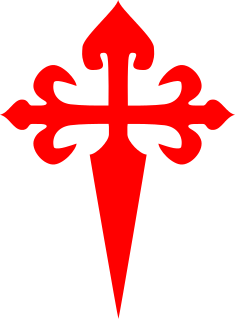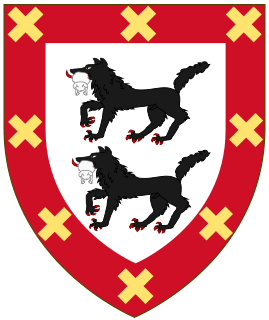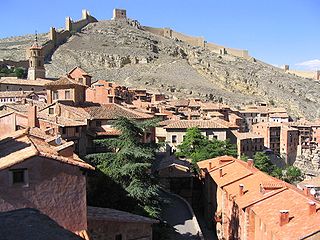Pedro Ruiz de Azagra (died 1186) was a Navarrese nobleman and soldier who established the independent Lordship of Albarracín, which lasted until 1284. He was the second son of Rodrigo Pérez de Azagra. His elder brother was Gonzalo Ruiz and his younger brother, later successor, was Fernán Ruiz.

The Kingdom of Navarre, originally the Kingdom of Pamplona, was a Basque-based kingdom that occupied lands on either side of the western Pyrenees, alongside the Atlantic Ocean between present-day Spain and France.

The Lordship of Albarracín was an independent Christian lordship in the Kingdom of Aragón located in and around the city of Albarracín. Its location was a buffer wedged between the Kingdom of Aragón and the Kingdom of Castile. The Señorío was created after the partition of the Taifa of Albarracín belonging to the Berber line of Banu Razín.
Pedro married Toda (or Tota) Pérez, the daughter of another Navarrese nobleman, Pedro de Arazuri. These two Pedros left Navarre about the same time, probably because they did not accept the succession of Sancho VI in 1154, after the death of his (elected) father, García Ramírez. [1] He ended up in the service of Muhammad ibn Mardanis, ruler of the taifas of Valencia and Murcia. Between 1166 and 1168 [2] (or perhaps as late as 1169–70), [3] Ibn Mardanis entrusted to him the lordship of Albarracín to defend his taifa's northern borders from the expansionist Alfonso II of Aragon. Pedro immediately began Christianising his lordship, refounding churches and erecting a bishopric. His refusal to recognise Aragonese sovereignty extended to his bishop, Martin, who refused to recognise the supremacy of the Bishop of Zaragoza, though ordered to do so by the pope. [1] [2] Pedro also colonised the region of Albarracín, mostly with settlers from Navarre. [1]

Sancho Garcés VI, called the Wise was King of Navarre from 1150 until his death in 1194. He was the first monarch to officially drop the title of King of Pamplona in favour of King of Navarre, thus changing the designation of his kingdom. Sancho Garcés was responsible for bringing his kingdom into the political orbit of Europe. He was the eldest son of García Ramírez, the Restorer and Margaret of L'Aigle.

In the history of the Iberian Peninsula, a taifa was an independent Muslim-ruled principality, of which a number were formed in Al-Andalus after the final collapse of the Umayyad Caliphate of Córdoba in 1031. Most of these were emirates, but there was one oligarchy, Seville.

The Taifa of Valencia was a medieval Moorish taifa kingdom which existed, in and around Valencia, Spain during four distinct periods: from 1010 to 1065, from 1075 to 1099, from 1145 to 1147 and last from 1229 to 1238 when it was finally conquered by the Aragon.
Pedro was generally on friendly terms with Navarre and with Alfonso VIII of Castile. In August 1170, he and his brother Gonzalo were part of an embassy sent by Alfonso VIII to meet his fiancée, Eleanor, in Bordeaux and conduct her back to him. [4] Yet even when his father-in-law aligned with Castile, Pedro remained neutral. [1] In 1172, Cerebrun, the Archbishop of Toledo in Castile and the primate of Spain, consecrated the bishop of Santa María de Albarracín and attached it to his diocese. [2] In 1176, Pedro first called himself a "vassal of Saint Mary", a title to be employed by most of his successors, claiming no suzerain on Earth, only the Virgin Mary in heaven. [5]
Alfonso VIII, called the Noble or the one of the Navas, was the King of Castile from 1158 to his death and King of Toledo. He is most remembered for his part in the Reconquista and the downfall of the Almohad Caliphate. After having suffered a great defeat with his own army at Alarcos against the Almohads in 1195, he led the coalition of Christian princes and foreign crusaders who broke the power of the Almohads in the Battle of Las Navas de Tolosa in 1212, an event which marked the arrival of a tide of Christian supremacy on the Iberian peninsula.

Bordeaux is a port city on the Garonne in the Gironde department in Southwestern France.
A certain "Peire Rois" mentioned in the poem Quan vei pels vergiers despleiar, a sirventes by Bertran de Born, is probably Pedro. Composed probably in 1184, the song is Bertran's second anti-Aragonese screed. [4]
The sirventes or serventes, sometimes translated as "service song", was a genre of Old Occitan lyric poetry practiced by the troubadours.

Bertran de Born was a baron from the Limousin in France, and one of the major Occitan troubadours of the twelfth century.
Pedro left no sons and was succeeded by his younger brother Fernán. He did leave behind a daughter, named Toda after her mother, and who married Diego López II de Haro and died on 16 January 1216. [6]

Diego López II de Haro called the Good or the Bad. Son of Lope Diaz I de Haro, count of Nájera and of countess Aldonza. He was a first rank magnate in the kingdom of Castile under King Alfonso VIII (1158–1214). He played a decisive role in the rise of the Haro dynasty, as well as in the construction of the nobiliary identity of his group, who was to dominate the Castilian political society during the whole 13th century. A publicity strife around this key figure between his successors and the monarchy, in a moment of deep political troubles, led to the elaboration of his dark image and his golden legend at the end of the 13th century, and the invention of his opposite nicknames.











